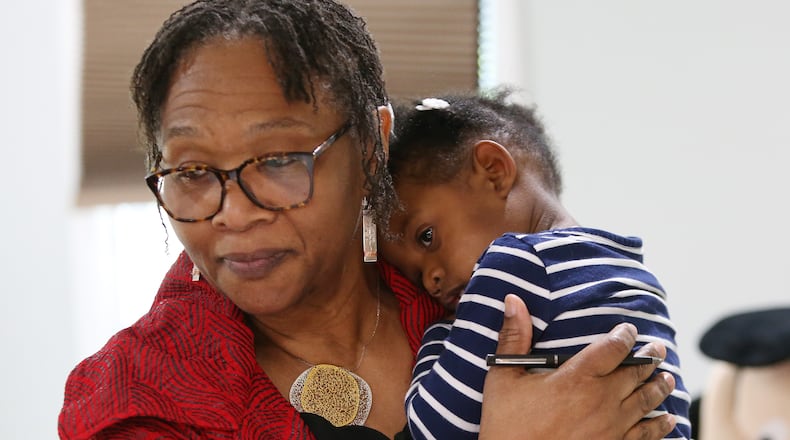After much work, one of the greatest contradictions of governmental policy in Georgia – political, theological and moral in aspect – has been crystallized into a 14-page report.
Georgia is one of the 10 most dangerous states in the U.S. to be a new mother. Our maternal mortality rate is among the highest in the developed world.
More disturbing is the fact that African-American mothers, particularly those in rural Georgia, are bearing most of the risk. A close examination of maternal deaths in 2012, 2013 and 2014 found that new black mothers in Georgia died at a rate of “three to four times higher” than white mothers – about 47 deaths for every 100,000 births. The national average is 17 deaths per 100,000 births.
Some bleed out. Others fall to strokes or succumb to heart disease. Sixty percent of the deaths are deemed preventable.
A special House committee, chaired by state Reps. Sharon Cooper, R-Marietta, and Mark Newton, R-Augusta, wrapped up four months of work on the topic this week, with a list of proposed fixes.
At the top: Extend Georgia’s Medicaid coverage for eligible pregnant women to a full year after giving birth. More than 50% of roughly 130,000 annual births in Georgia are covered under the program. Aid for most is currently cut off after 60 days.
In a legislative session that begins Monday and is anticipated to focus on budget cuts, Republican leaders in the state Capitol are already balking.
Here’s the question that GOP lawmakers must ask themselves this winter: Perhaps you have passed the strongest anti-abortion legislation possible. But if in practice your policies encourage pregnant women to consider abortion out of a sense of self-preservation, can you still call yourself pro-life?
Cooper, who chairs the House Health and Human Services Committee, will be making that argument more politely over the next three months. She is willing to take half a loaf.
“I’m a nurse and I believe in doing triage. You treat the person that is in the most serious trouble and can be saved. You find and treat them first,” she told me this week.
“Most of the deaths occur within the first six months,” Cooper said. “I’ve been begging for a year’s extension for months. In a tight budget, a year might not be feasible. But if I can get six months, I’ll take six months. And let’s see what a difference that six months makes.”
The recommendation from the House maternal mortality committee is separate from Gov. Brian Kemp’s application to the Trump administration for a Medicaid waiver that would modestly expand health care coverage for Georgia’s poor. Approval, if it comes, is expected to take months. Under Kemp’s plan, recipients would be required to work, go to school, or volunteer for a set number of hours each week — stipulations likely to be barriers to new mothers.
And so health insurance coverage was a delicate topic for most of the medical and health care experts who paraded through five different hearings this fall. Doug Miller, vice dean at Medical College of Georgia in Augusta, was blunter than most.
“The solution to this problem is societal, in part, but it’s also related to access to primary-care physicians,” Miller said at an October hearing.
Ninety-three rural counties in Georgia have no hospital with a labor and delivery unit. Two-thirds of rural births in Georgia occur outside of the mother’s home county.
“It is clear that access to those services are being metered or being throttled back for a variety of reasons, but it’s mostly money, distance and access to care,” he said. “When this state has primary care available to every single woman, that number will go down to nine in 100,000. It’s as simple as that.”
Broad societal factors are also involved. Obesity is one. The fact that many mothers are older is another. The risk of death for mothers 35 and older is three times that of mothers 25 and younger.
But at an important structural level, Georgia’s maternal mortality problem also has something in common with our continuing debate over voting and ballot access.
As became clear during the 2018 race for governor, the secretary of state may oversee Georgia elections, but most of the important decisions – locations of polling stations and such — are made by 159 county election boards across the state.
The state’s public health care system operates in much the same way. So local attitudes matter, particularly in the swath of majority-black counties that stretch from Augusta to Macon to Columbus.
“We have a public health facility in every single county. That’s the closest place to the people. The problem is the state gives public health districts money, but we don’t run them,” Cooper said. “And we can’t say to every one of the public health districts, ‘You will do prenatal care. You will do postpartum care.’
“We have some counties that see the importance and have made it a priority. They’re using tele-medicine. Others are not,” Cooper said. Some simply dole out vaccines, keep statistics, and hew to 8 a.m. to 4 p.m. office hours that put any services they might offer out of the reach of working mothers.
“If you drive around this state, you’ll often see one car in front of the public health department all day long, and nobody else,” Cooper said. “And the one car belongs to the nurse that works there.”
Under-used county health departments are wasted resource, and No. 3 on her committee’s list of things to be fixed. Cooper said the state Department of Public Health is already working on it.
“If you’ve already got a public health department and you’ve already got a staff, that cuts down on the money a whole lot,” Cooper said.
For it is, in the end, all about the money.
About the Author
The Latest
Featured




